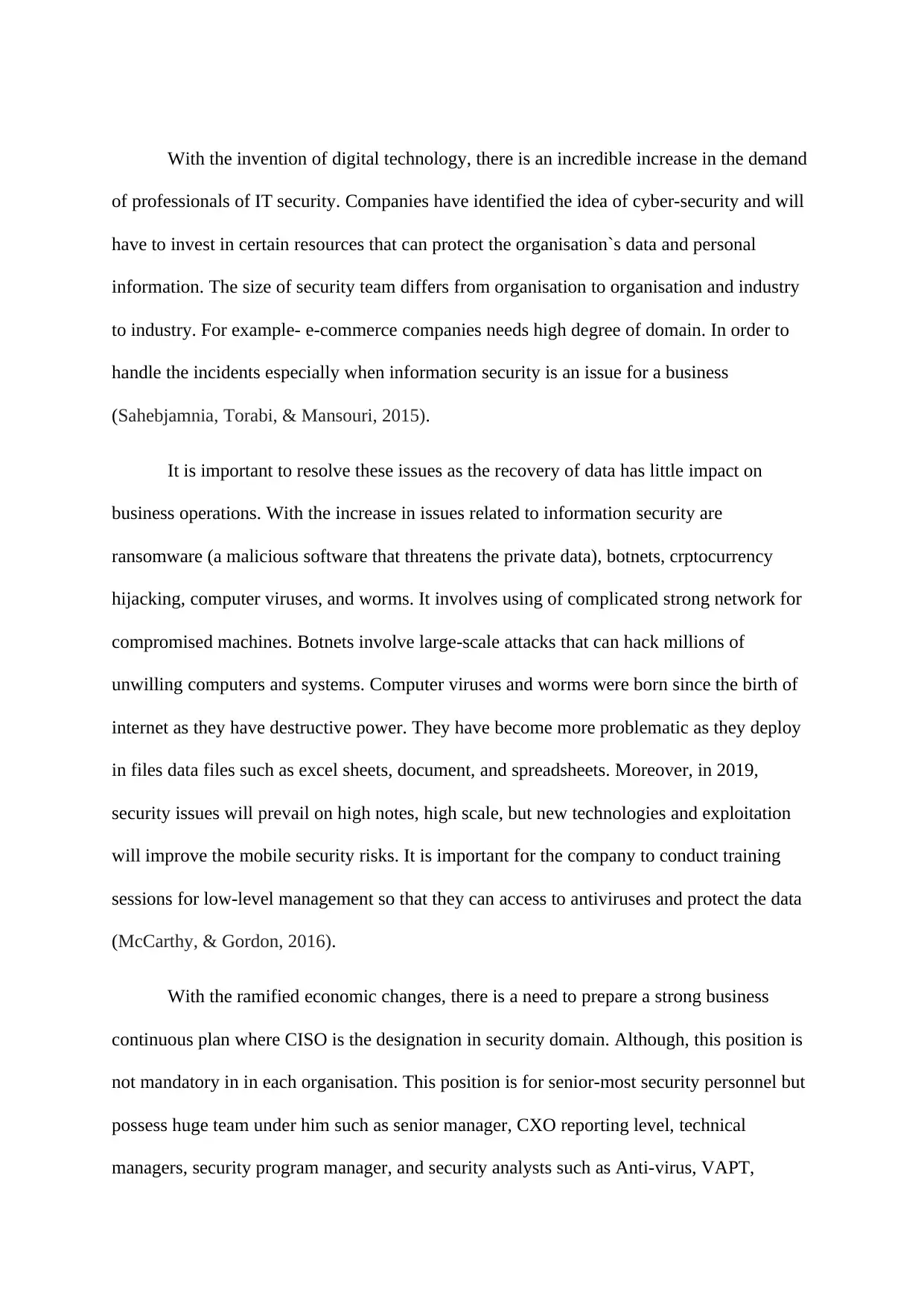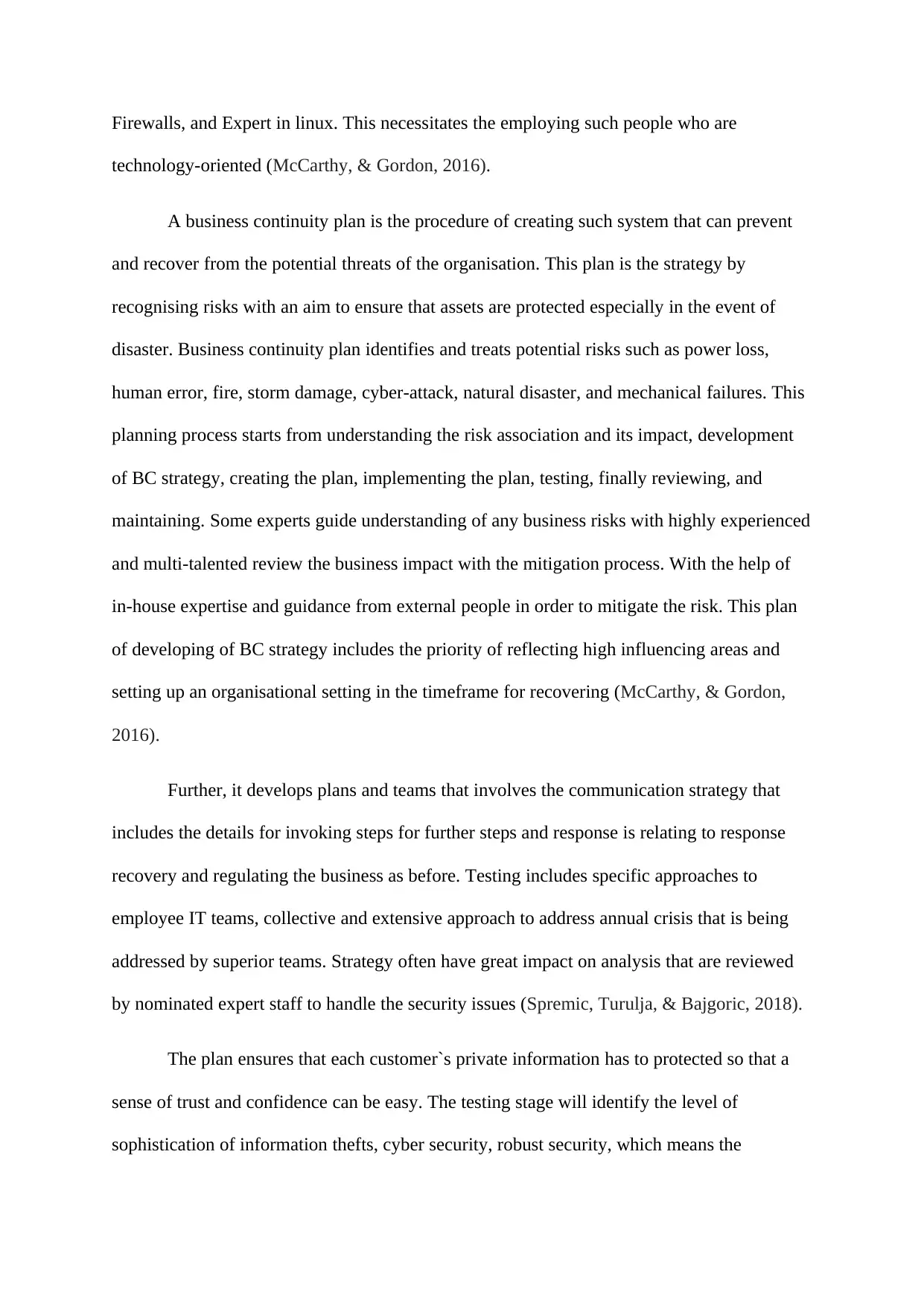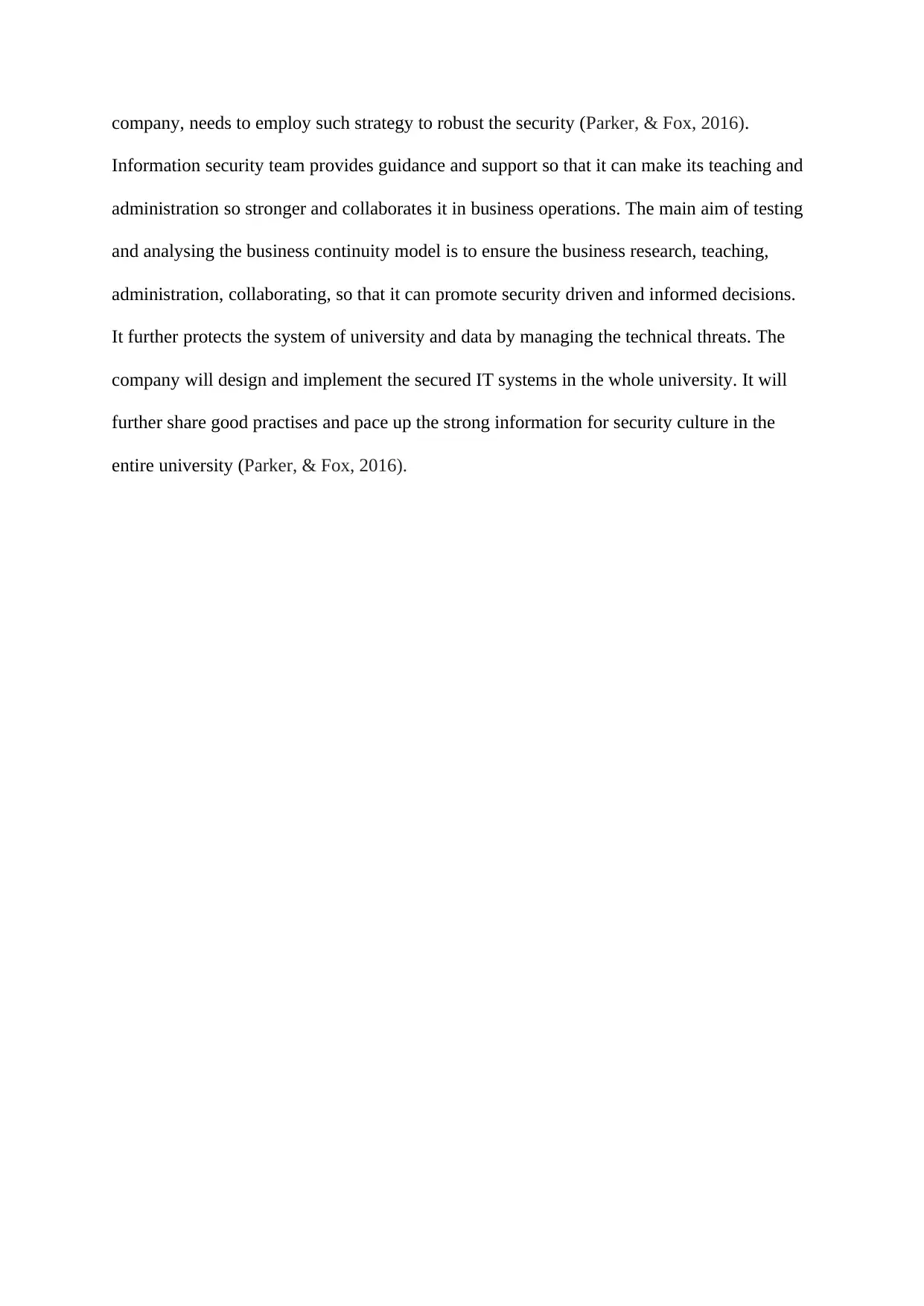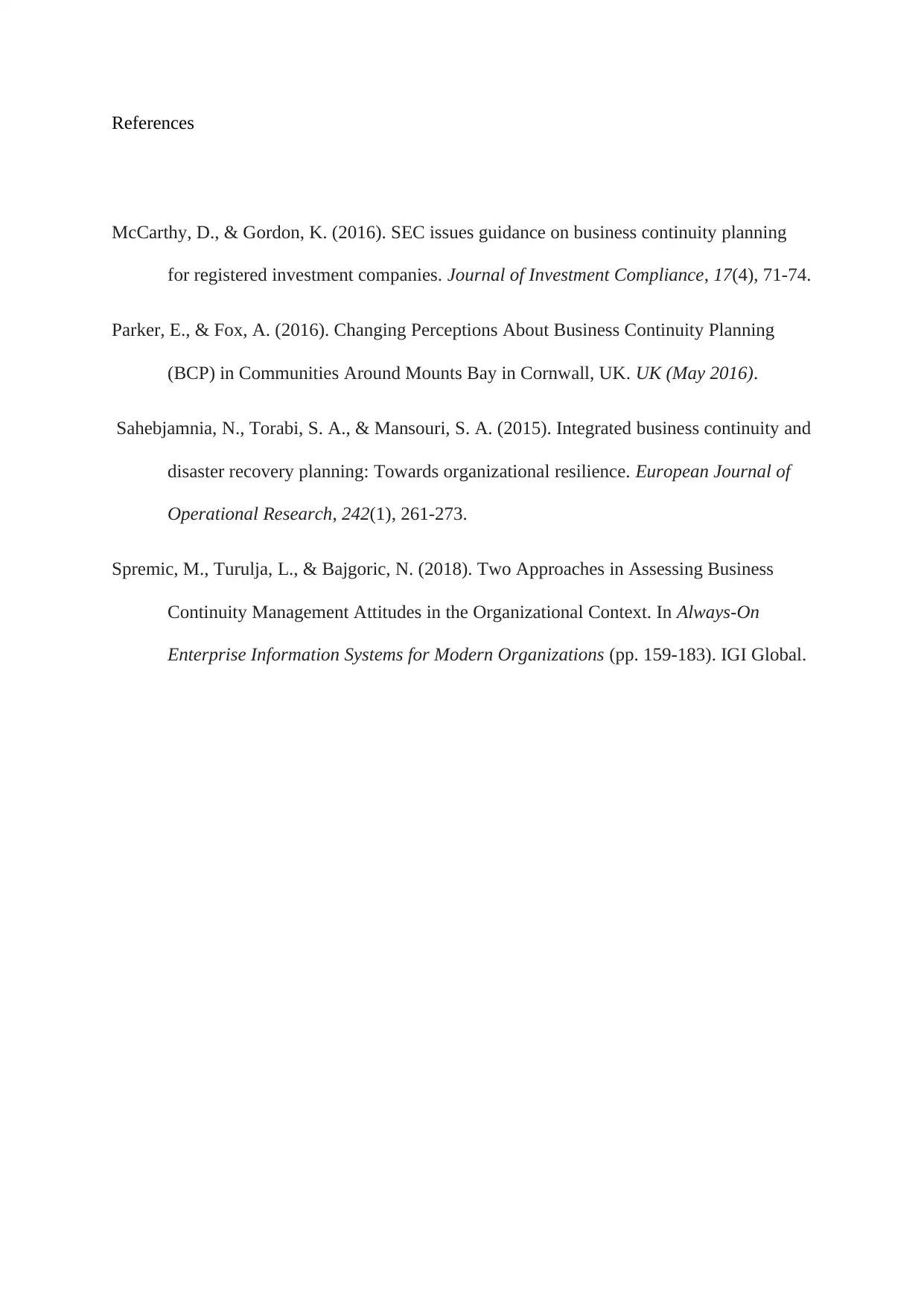Detailed Business Continuity Plan (BCP) and Security Report
VerifiedAdded on 2023/01/17
|5
|1012
|61
Report
AI Summary
This report presents a detailed Business Continuity Plan (BCP) focusing on the increasing importance of IT security in the digital age. It highlights the necessity for organizations to invest in resources that protect data and personal information, addressing threats like ransomware, botnets, and computer viruses. The report emphasizes the role of a Business Continuity Plan in preventing and recovering from potential threats, including power loss, cyber-attacks, and natural disasters. It outlines the BCP process, from risk assessment to plan implementation, testing, and maintenance, and stresses the importance of training and expert guidance. Furthermore, it highlights the importance of protecting customer information and ensuring robust security measures, including the development of secured IT systems and the promotion of a strong information security culture.

BUSINESS CONTINUITY PLAN
(BCP)
(BCP)
Paraphrase This Document
Need a fresh take? Get an instant paraphrase of this document with our AI Paraphraser

With the invention of digital technology, there is an incredible increase in the demand
of professionals of IT security. Companies have identified the idea of cyber-security and will
have to invest in certain resources that can protect the organisation`s data and personal
information. The size of security team differs from organisation to organisation and industry
to industry. For example- e-commerce companies needs high degree of domain. In order to
handle the incidents especially when information security is an issue for a business
(Sahebjamnia, Torabi, & Mansouri, 2015).
It is important to resolve these issues as the recovery of data has little impact on
business operations. With the increase in issues related to information security are
ransomware (a malicious software that threatens the private data), botnets, crptocurrency
hijacking, computer viruses, and worms. It involves using of complicated strong network for
compromised machines. Botnets involve large-scale attacks that can hack millions of
unwilling computers and systems. Computer viruses and worms were born since the birth of
internet as they have destructive power. They have become more problematic as they deploy
in files data files such as excel sheets, document, and spreadsheets. Moreover, in 2019,
security issues will prevail on high notes, high scale, but new technologies and exploitation
will improve the mobile security risks. It is important for the company to conduct training
sessions for low-level management so that they can access to antiviruses and protect the data
(McCarthy, & Gordon, 2016).
With the ramified economic changes, there is a need to prepare a strong business
continuous plan where CISO is the designation in security domain. Although, this position is
not mandatory in in each organisation. This position is for senior-most security personnel but
possess huge team under him such as senior manager, CXO reporting level, technical
managers, security program manager, and security analysts such as Anti-virus, VAPT,
of professionals of IT security. Companies have identified the idea of cyber-security and will
have to invest in certain resources that can protect the organisation`s data and personal
information. The size of security team differs from organisation to organisation and industry
to industry. For example- e-commerce companies needs high degree of domain. In order to
handle the incidents especially when information security is an issue for a business
(Sahebjamnia, Torabi, & Mansouri, 2015).
It is important to resolve these issues as the recovery of data has little impact on
business operations. With the increase in issues related to information security are
ransomware (a malicious software that threatens the private data), botnets, crptocurrency
hijacking, computer viruses, and worms. It involves using of complicated strong network for
compromised machines. Botnets involve large-scale attacks that can hack millions of
unwilling computers and systems. Computer viruses and worms were born since the birth of
internet as they have destructive power. They have become more problematic as they deploy
in files data files such as excel sheets, document, and spreadsheets. Moreover, in 2019,
security issues will prevail on high notes, high scale, but new technologies and exploitation
will improve the mobile security risks. It is important for the company to conduct training
sessions for low-level management so that they can access to antiviruses and protect the data
(McCarthy, & Gordon, 2016).
With the ramified economic changes, there is a need to prepare a strong business
continuous plan where CISO is the designation in security domain. Although, this position is
not mandatory in in each organisation. This position is for senior-most security personnel but
possess huge team under him such as senior manager, CXO reporting level, technical
managers, security program manager, and security analysts such as Anti-virus, VAPT,

Firewalls, and Expert in linux. This necessitates the employing such people who are
technology-oriented (McCarthy, & Gordon, 2016).
A business continuity plan is the procedure of creating such system that can prevent
and recover from the potential threats of the organisation. This plan is the strategy by
recognising risks with an aim to ensure that assets are protected especially in the event of
disaster. Business continuity plan identifies and treats potential risks such as power loss,
human error, fire, storm damage, cyber-attack, natural disaster, and mechanical failures. This
planning process starts from understanding the risk association and its impact, development
of BC strategy, creating the plan, implementing the plan, testing, finally reviewing, and
maintaining. Some experts guide understanding of any business risks with highly experienced
and multi-talented review the business impact with the mitigation process. With the help of
in-house expertise and guidance from external people in order to mitigate the risk. This plan
of developing of BC strategy includes the priority of reflecting high influencing areas and
setting up an organisational setting in the timeframe for recovering (McCarthy, & Gordon,
2016).
Further, it develops plans and teams that involves the communication strategy that
includes the details for invoking steps for further steps and response is relating to response
recovery and regulating the business as before. Testing includes specific approaches to
employee IT teams, collective and extensive approach to address annual crisis that is being
addressed by superior teams. Strategy often have great impact on analysis that are reviewed
by nominated expert staff to handle the security issues (Spremic, Turulja, & Bajgoric, 2018).
The plan ensures that each customer`s private information has to protected so that a
sense of trust and confidence can be easy. The testing stage will identify the level of
sophistication of information thefts, cyber security, robust security, which means the
technology-oriented (McCarthy, & Gordon, 2016).
A business continuity plan is the procedure of creating such system that can prevent
and recover from the potential threats of the organisation. This plan is the strategy by
recognising risks with an aim to ensure that assets are protected especially in the event of
disaster. Business continuity plan identifies and treats potential risks such as power loss,
human error, fire, storm damage, cyber-attack, natural disaster, and mechanical failures. This
planning process starts from understanding the risk association and its impact, development
of BC strategy, creating the plan, implementing the plan, testing, finally reviewing, and
maintaining. Some experts guide understanding of any business risks with highly experienced
and multi-talented review the business impact with the mitigation process. With the help of
in-house expertise and guidance from external people in order to mitigate the risk. This plan
of developing of BC strategy includes the priority of reflecting high influencing areas and
setting up an organisational setting in the timeframe for recovering (McCarthy, & Gordon,
2016).
Further, it develops plans and teams that involves the communication strategy that
includes the details for invoking steps for further steps and response is relating to response
recovery and regulating the business as before. Testing includes specific approaches to
employee IT teams, collective and extensive approach to address annual crisis that is being
addressed by superior teams. Strategy often have great impact on analysis that are reviewed
by nominated expert staff to handle the security issues (Spremic, Turulja, & Bajgoric, 2018).
The plan ensures that each customer`s private information has to protected so that a
sense of trust and confidence can be easy. The testing stage will identify the level of
sophistication of information thefts, cyber security, robust security, which means the
⊘ This is a preview!⊘
Do you want full access?
Subscribe today to unlock all pages.

Trusted by 1+ million students worldwide

company, needs to employ such strategy to robust the security (Parker, & Fox, 2016).
Information security team provides guidance and support so that it can make its teaching and
administration so stronger and collaborates it in business operations. The main aim of testing
and analysing the business continuity model is to ensure the business research, teaching,
administration, collaborating, so that it can promote security driven and informed decisions.
It further protects the system of university and data by managing the technical threats. The
company will design and implement the secured IT systems in the whole university. It will
further share good practises and pace up the strong information for security culture in the
entire university (Parker, & Fox, 2016).
Information security team provides guidance and support so that it can make its teaching and
administration so stronger and collaborates it in business operations. The main aim of testing
and analysing the business continuity model is to ensure the business research, teaching,
administration, collaborating, so that it can promote security driven and informed decisions.
It further protects the system of university and data by managing the technical threats. The
company will design and implement the secured IT systems in the whole university. It will
further share good practises and pace up the strong information for security culture in the
entire university (Parker, & Fox, 2016).
Paraphrase This Document
Need a fresh take? Get an instant paraphrase of this document with our AI Paraphraser

References
McCarthy, D., & Gordon, K. (2016). SEC issues guidance on business continuity planning
for registered investment companies. Journal of Investment Compliance, 17(4), 71-74.
Parker, E., & Fox, A. (2016). Changing Perceptions About Business Continuity Planning
(BCP) in Communities Around Mounts Bay in Cornwall, UK. UK (May 2016).
Sahebjamnia, N., Torabi, S. A., & Mansouri, S. A. (2015). Integrated business continuity and
disaster recovery planning: Towards organizational resilience. European Journal of
Operational Research, 242(1), 261-273.
Spremic, M., Turulja, L., & Bajgoric, N. (2018). Two Approaches in Assessing Business
Continuity Management Attitudes in the Organizational Context. In Always-On
Enterprise Information Systems for Modern Organizations (pp. 159-183). IGI Global.
McCarthy, D., & Gordon, K. (2016). SEC issues guidance on business continuity planning
for registered investment companies. Journal of Investment Compliance, 17(4), 71-74.
Parker, E., & Fox, A. (2016). Changing Perceptions About Business Continuity Planning
(BCP) in Communities Around Mounts Bay in Cornwall, UK. UK (May 2016).
Sahebjamnia, N., Torabi, S. A., & Mansouri, S. A. (2015). Integrated business continuity and
disaster recovery planning: Towards organizational resilience. European Journal of
Operational Research, 242(1), 261-273.
Spremic, M., Turulja, L., & Bajgoric, N. (2018). Two Approaches in Assessing Business
Continuity Management Attitudes in the Organizational Context. In Always-On
Enterprise Information Systems for Modern Organizations (pp. 159-183). IGI Global.
1 out of 5
Related Documents
Your All-in-One AI-Powered Toolkit for Academic Success.
+13062052269
info@desklib.com
Available 24*7 on WhatsApp / Email
![[object Object]](/_next/static/media/star-bottom.7253800d.svg)
Unlock your academic potential
Copyright © 2020–2025 A2Z Services. All Rights Reserved. Developed and managed by ZUCOL.





